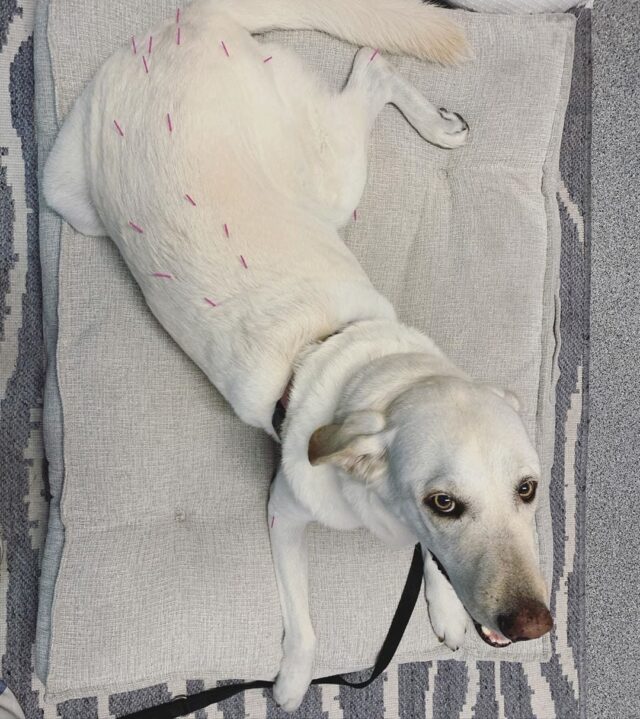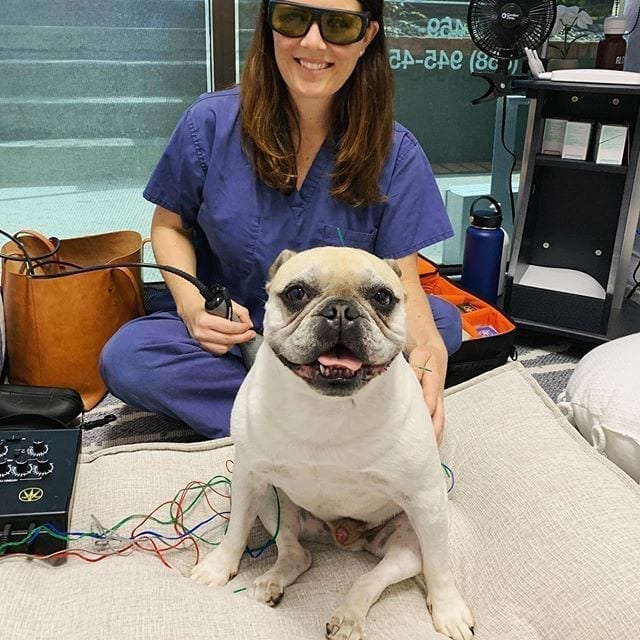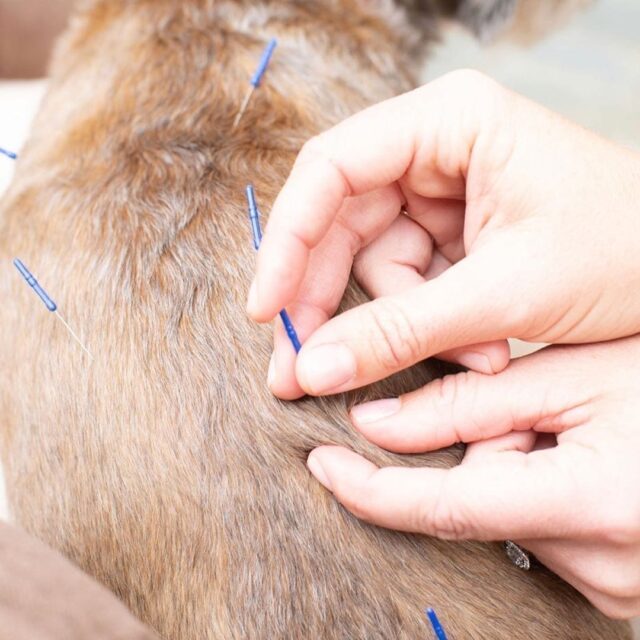Acupuncture may seem like some sort of ancient hocus pocus, but studies are showing that it can be a very useful tool in the field of canine veterinary medicine. How can sticking needles in your dog’s skin be anything but painful? What could it possibly be used to treat? What’s the future of acupuncture?
If you have an open mind about alternative therapies, you need to read on about this ancient – and also groundbreaking – treatment.

What is acupuncture, anyway?
According to PetMD:
“Acupuncture involves the insertion of needles into body tissue where nerve bundles and blood vessels come together. These collections of nervous and vascular tissue are termed acupuncture points, which course over all aspects of the body’s surface on meridians (energy channels). The meridians permit a cycle of energy to occur throughout the entire body over the course of the day’s 24 hours…
Veterinary acupuncture stimulates the release of the body’s own pain-relieving and anti-inflammatory substances. Relaxation of muscles at the site of needle insertion and more distant locations [in the] body is achieved with veterinary acupuncture treatment, creating both a local and generalized pain-relieving effect. Veterinary acupuncture improves tissue blood flow, oxygenation, and removal of metabolic wastes and toxins. Unlike prescription and over the counter pain medications, veterinary acupuncture lacks potential adverse side effects for your pet’s internal organs. Your pet’s medications or supplements will not adversely interact with veterinary acupuncture treatment; therefore it can safely be used to treat a variety of illnesses.”

With that in mind, here are 8 things you may not know about acupuncture:
#1 – It doesn’t hurt.
Most dogs hardly seem to notice the extremely skinny needles being placed into their skin. Some humans have reported feelings of numbness or tingling, and some dogs may react to these strange feelings, but acupuncture wouldn’t be growing into the popular therapy it is if dogs were crying out in pain every time a needle was inserted. No vet is interested in poking painful, unnecessary holes in your dog.
#2 – Many dogs find it relaxing.
Due to the release of endorphins (a feel-good hormone in your brain) caused by the inserting of the needle, many dogs actually relax to the point that they become sleepy during treatment.
#3 – It can help with a wide variety of health problems.
Acupuncture is used to treat pain of all kinds. It’s commonly used to treat pain and inflammation that are the result of trauma, arthritis, Degenerative Joint Disease (DJD), and cancer. It can ease symptoms related to metabolic diseases such as kidney and liver failure, pancreatitis, Cushing’s disease, Addison’s disease, hypothyroidism, and diabetes mellitus. Acupuncture can also improve the pain and symptoms of Intervertebral Disc Disease (IDD) as well as, if not better than, surgery.

#4 – There are several different types of treatments.
Acupuncture is no longer limited to just sticking needles in the skin.
-Acupressure
Instead of using needles, acupressure involves applying pressure on acupuncture points. This can be beneficial for dogs who are not tolerant of the needles or other situations where using needles would be difficult.
-Aquapuncture
This treatment injects homeopathic or medicated liquids into the acupuncture points instead of needles. This has the benefit of giving the energy an extra boost by pushing tissue out of the way.
-Moxibustion
According to PetMD, moxibustion is the:
“Application of a heated Chinese herbal compound to needles. Heat is very beneficial to pets that are older or suffering from conditions involving joint stiffness and/or muscular soreness.”
-Laser Therapy
are becoming an increasingly popular acupuncture tool. New lasers are cool and don’t produce heat that could harm your dog. Laser acupuncture is proving to be just as effective as traditional acupuncture, especially for dogs who are bothered by needles.
-Electrostimulation (E-Stim)
E-stim involves running a low level of electricity between the acupuncture needles. It can relax muscles that are spasming and may help re-establish nerve impulses after a nerve injury, such as IVDD.

#5 – There are few side effects.
Apart from the few dogs who are bothered by the needles, there are few reported side effects from acupuncture, making it a safe addition to nearly any treatment plan established by your veterinarian.
#6 – It works best in conjunction with – not instead of – more traditional treatments.
Acupuncture isn’t intended to replace traditional treatments. It is best used in a way that makes traditional treatments and therapies more effective rather than as a treatment all by itself. A dog in pain may still need medication with acupuncture, but the goal is usually to reduce the amount of medication the dog needs rather than eliminate it entirely.
#7 – There is evidence that it works.
There are a variety of different types of studies showing the effectiveness of acupuncture and a little bit about how it works. MRI scans have shown changes in patients’ nerves and brains after treatment. Endorphins were released and messages sending pain signals to the brain were blocked. Both of these things would help bring relief from pain.
Many studies have also shown the effectiveness of electroacupuncture (EAP) after – or even instead of – decompression surgery for IVDD. In one study, EAP actually produced better results than surgery. In other studies, dogs receiving EAP needed less pain medication and recovered faster than dogs who didn’t receive EAP.

#8 – The effects are cumulative.
One session of acupuncture can be helpful, but since the effects are cumulative, regular treatments are much more effective than sporadic ones. As symptoms improve, the frequency of treatments can lessen.
 Toledo, United States.
Toledo, United States.